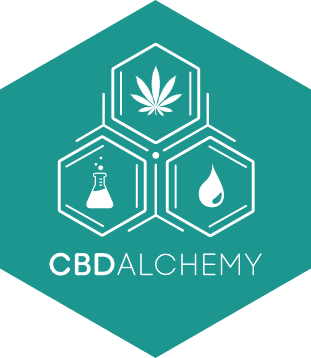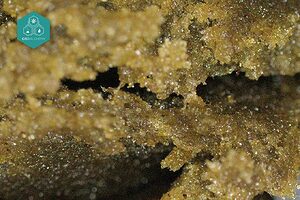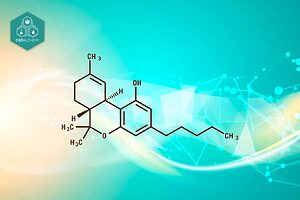- What Are Terpenes? Definition and Structure
- Types of Terpenes and Their Properties
- Terpenes in Cannabis
- Health Benefits of Terpenes
- Natural Sources of Terpenes
- Practical Applications of Terpenes
- Frequently Asked Questions About Terpenes
- References and Sources

Terpenes are aromatic organic compounds produced by various plants, including cannabis, responsible for its characteristic aroma and flavor. In addition to their organoleptic properties, these compounds interact with cannabinoids such as CBD and THC, enhancing their therapeutic effects through the so-called “entourage effect”, although the experience may vary according to each person’s individual genetics.
For more detailed information on terpenes and their impact on wellness and health, we invite you to delve deeper into this article.
What Are Terpenes? Definition and Structure
Chemical Definition and Classification
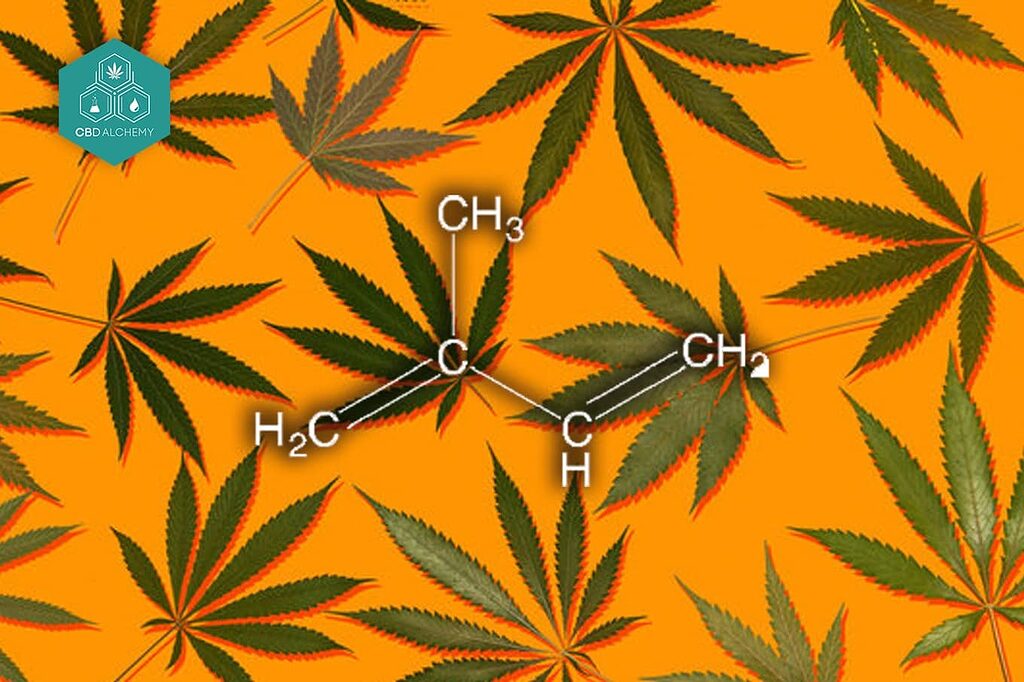
Terpenes constitute a large family of organic compounds produced naturally by numerous plants, including cannabis. Chemically, they are hydrocarbons made up of isoprene units (C₅H₈), a molecule of five carbon atoms that acts as the fundamental building block of these compounds.
Isoprene-Based Molecular Composition
The basic structure of terpenes follows the isoprene rule, also known as Wallach’s rule, where each terpene is composed of a specific number of isoprene units bonded together. This characteristic allows them to be classified according to the number of units they contain: monoterpenes (2 units), sesquiterpenes (3 units), diterpenes (4 units), and so on.
The chemical structure and spatial arrangement of these isoprene units determine the physical and chemical properties of each terpene, including its aroma, flavor and biological effects. For example, limonene, with its characteristic citrus aroma, and pinene, with its pine fragrance, are both monoterpenes but with different three-dimensional structures that give them different properties.
Difference Between Terpenes and Terpenoids
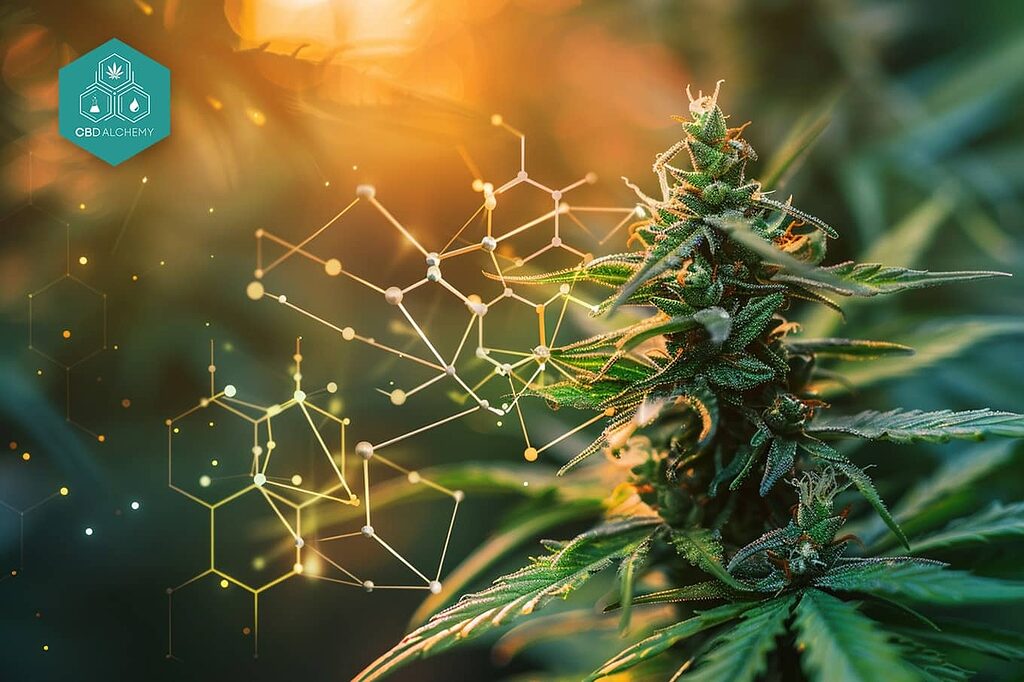
Although often used interchangeably, there is an important chemical difference between terpenes and terpenoids. Terpenes are pure hydrocarbons composed exclusively of carbon and hydrogen, while terpenoids are modified terpenes containing additional functional groups, usually with oxygen.
Terpenoids are formed when terpenes are oxidized during the drying and curing process of cannabis. This oxidation slightly modifies the molecular structure, potentially altering their properties and effects. In the context of cannabis, both compounds contribute to the aromatic and therapeutic profile of the plant, working in conjunction with cannabinoids.
Biological Function in Plants
Terpenes play vital roles in the survival and reproduction of the plants that produce them. Far from being mere aromatic compounds, they represent sophisticated evolutionary mechanisms that plants have developed over millions of years.
Natural Defense Mechanisms
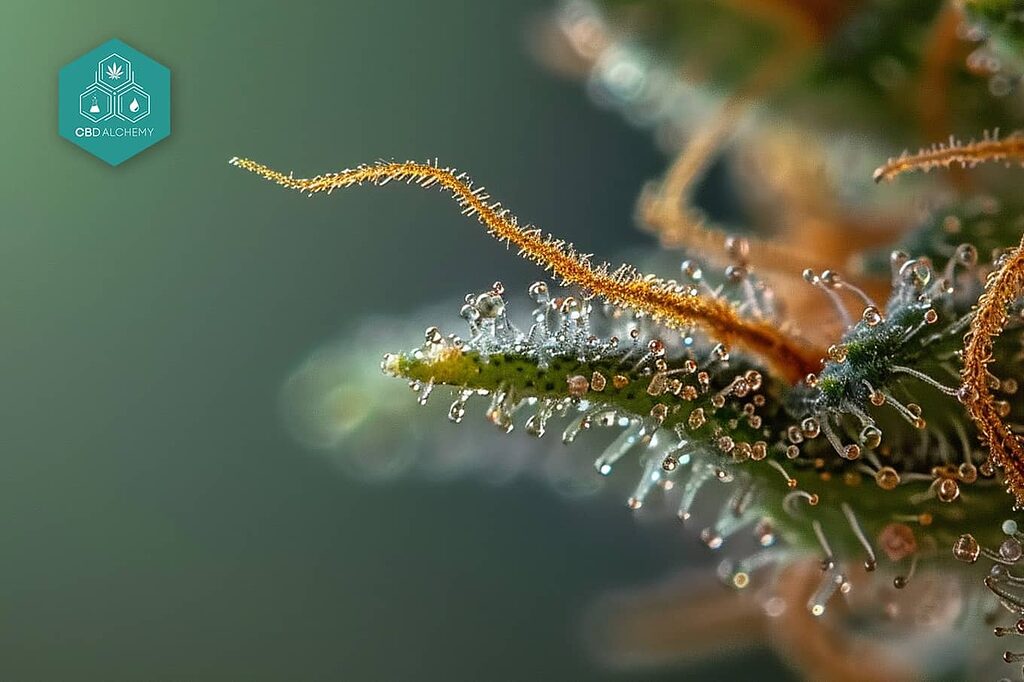
One of the primary functions of terpenes is protection against external threats. Many terpenes possess antimicrobial, antifungal and insecticidal properties that help plants defend against pathogens and insect herbivores. For example, pinene, abundant in conifers, acts as a natural insect repellent, while caryophyllene exhibits potent antifungal properties.
Marijuana plants produce a rich variety of terpenes in their trichomes, small resinous glands that mainly cover the flowers and, to a lesser extent, the leaves. This concentration of terpenes in the reproductive structures underlines their importance as a defense mechanism to protect the most valuable parts of the plant.
Pollinator Attraction
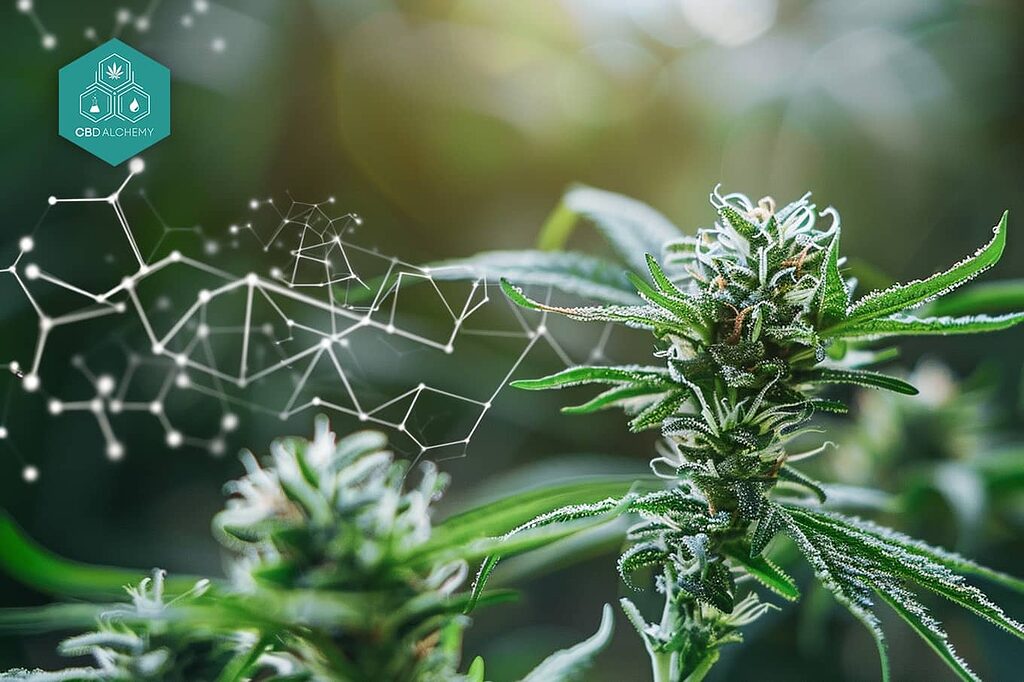
Paradoxically, while some terpenes repel harmful organisms, others attract beneficial pollinators. The floral, fruity and sweet aromas produced by certain terpenes serve as olfactory signals to bees, butterflies and other pollinators, facilitating plant reproduction.
In cannabis, although primarily wind-pollinated, terpenes can attract insects that contribute to pollen dispersal or feed on other harmful insects, creating a protective micro-ecosystem around the plant.
Growth Regulation
Some terpenes function as plant growth regulators and mediators of plant-to-plant communication. Certain volatile terpenes released by plants under stress can alert neighboring plants to impending threats, allowing them to activate their own defense mechanisms preemptively.
In cannabis, terpene production varies according to environmental factors such as temperature, humidity, light exposure and nutrient availability. This plasticity in terpene synthesis allows the plant to adapt to changing conditions, optimizing its growth and survival in diverse environments.
Types of Terpenes and Their Properties
Monoterpenes
Monoterpenes, composed of two isoprene units (10 carbon atoms), are the most abundant and volatile terpenes in cannabis. Their low molecular weight gives them a high volatility, being responsible for the most immediate and penetrating aromas of the plant.
Limonene: Properties and Effects

Limonene, recognizable by its characteristic citrus aroma, is one of the most common monoterpenes in nature and abundant in certain strains of cannabis. It is found primarily in the peel of citrus fruits such as lemons and oranges, as well as in cannabis strains with fresh, citrusy aroma profiles.
This terpene has demonstrated anxiolytic and antidepressant properties in scientific studies, potentially raising serotonin and dopamine levels in the brain. Preliminary research also suggests anti-inflammatory, antioxidant and potentially anti-cancer properties, highlighting its effectiveness in the chemoprevention and chemotherapy of various types of cancers such as breast, lung and stomach cancer, although further clinical studies are required to confirm these effects in humans.
In the context of cannabis, limonene may contribute to energizing and mood elevating effects, complementing the action of THC in stimulant strains. However, the individual response may vary significantly depending on the genetic makeup of each person.
Pinene: Properties and Effects
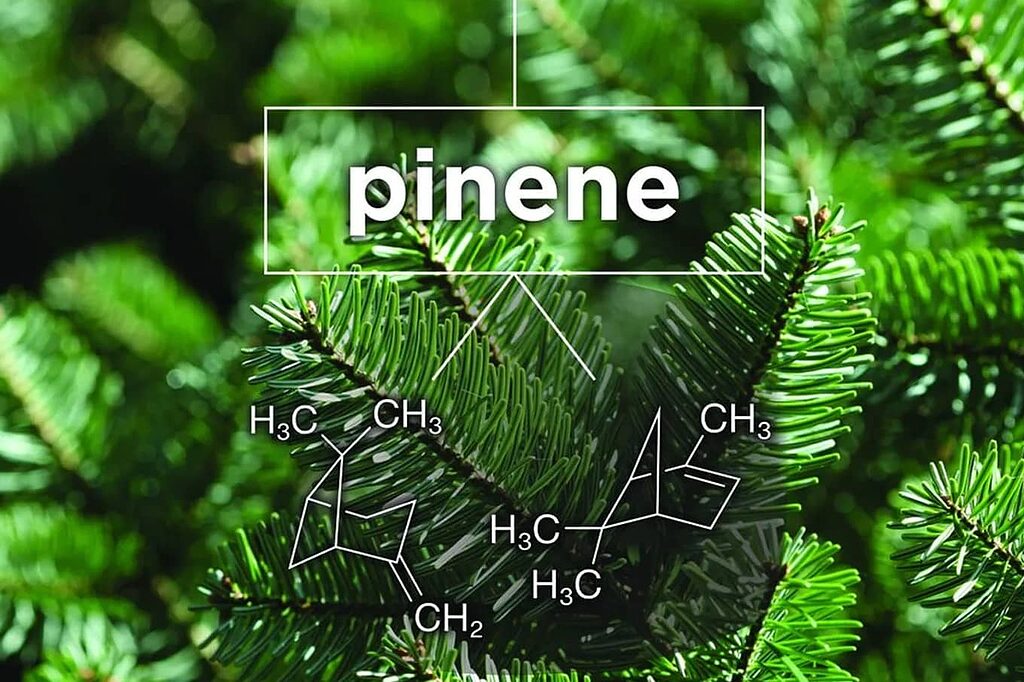
Alpha- and beta-pinene, with their distinctive pine and forest aroma, are monoterpenes abundant in both conifers and certain strains of cannabis. Alpha-pinene is the most common terpene in nature, found in rosemary, sage, eucalyptus and numerous pine species.
Scientific studies have identified bronchodilator properties in pinene, potentially beneficial for respiratory conditions. It also shows anti-inflammatory effects and acts as an acetylcholinesterase inhibitor, potentially improving memory and counteracting the short-term cognitive impairment effects associated with THC.
In cannabis, pinene-rich strains often produce more mentally alert and clearer effects, potentially reducing the confusion or anxiety that some people experience with THC. This interaction exemplifies how terpenes can significantly modulate the effects of cannabinoids.
Sesquiterpenes
Sesquiterpenes, consisting of three isoprene units (15 carbon atoms), are less volatile than monoterpenes due to their higher molecular weight. These compounds tend to impart deeper, earthier and more complex aromas to cannabis.
Beta-Caryophyllene: Properties and Effects
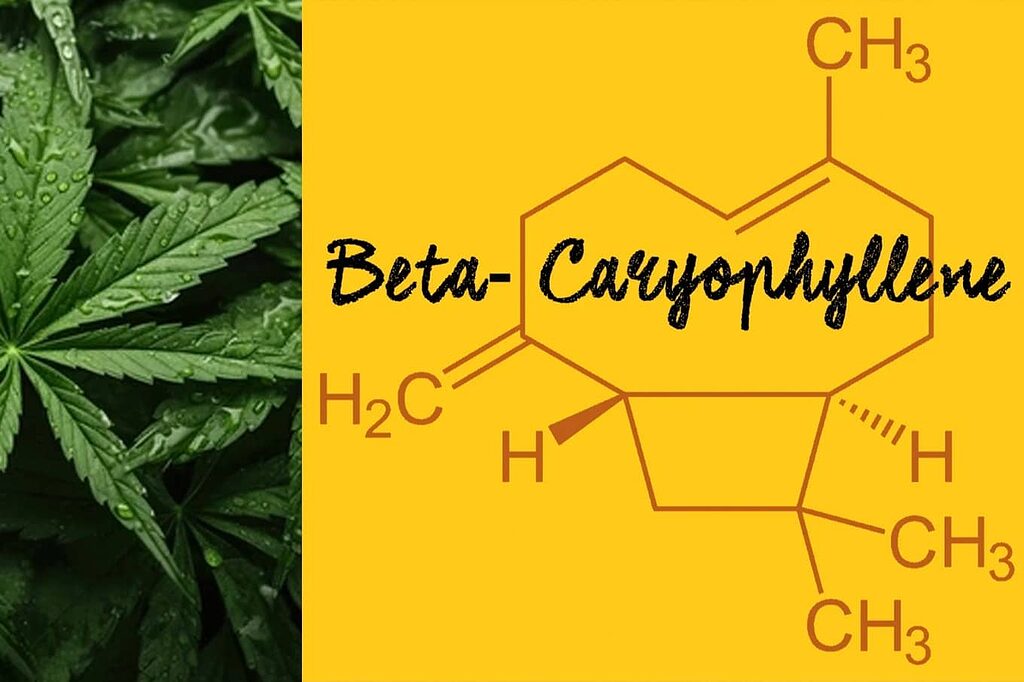
Beta-caryophyllene stands out among terpenes as the only one known to directly interact with the endocannabinoid system, specifically with CB2 receptors. This unique characteristic gives it a special status, being considered both a terpene and a dietary cannabinoid. In addition, beta-caryophyllene may act as a precursor in the production of other beneficial compounds.
Abundant in black pepper, clove and cinnamon, as well as numerous cannabis strains, beta-caryophyllene possesses potent anti-inflammatory properties documented in multiple scientific studies. Its affinity for CB2 receptors, present primarily in the immune system, partly explains these anti-inflammatory effects without producing the psychoactive effects associated with CB1 receptor activation.
Recent research suggests that beta-caryophyllene may have therapeutic applications for chronic inflammatory conditions, neuropathic pain and potentially for anxiety disorders. In cannabis, it contributes to calming and analgesic effects, complementing the action of cannabinoids such as CBD.
Humulene: Properties and Effects
Humulene, with its characteristic earthy and hoppy aroma, is a sesquiterpene present in cannabis, hops (an essential component of beer) and plants such as ginseng and sage. Historically it has been used in the traditional medicine of various cultures.
Scientific studies have identified anti-inflammatory, antibacterial and potentially anticarcinogenic properties in humulene. An interesting feature of this terpene is its potential appetite suppressant effect, contrasting with the well-known appetite stimulant effect associated with cannabis, mainly attributed to THC.
In the context of cannabis, humulene contributes to more balanced and less appetite-stimulating effect profiles, especially in strains that also contain significant amounts of other terpenes such as pinene or limonene.
Diterpenes and Triterpenes
Diterpenes (20 carbon atoms) and triterpenes (30 carbon atoms) are more complex and less volatile terpenes due to their higher molecular weight. Although less abundant in cannabis than monoterpenes and sesquiterpenes, they play important roles in the plant and potentially in its therapeutic effects.
Examples and Characteristics
Among the relevant diterpenes in cannabis is phytol, a component of chlorophyll that is released during combustion or vaporization. Preliminary studies suggest that phytol may have anti-inflammatory and antioxidant properties.
Triterpenes include compounds such as friedelin and epifriedelanol, identified in cannabis but present in relatively low concentrations. These compounds have shown anti-inflammatory and anti-cancer potential in preliminary studies, although their contribution to the therapeutic profile of cannabis requires further investigation.
The lower volatility of these more complex terpenes means that they are less detectable in the aroma of cannabis, but may contribute significantly to its effects when consumed, especially in full-spectrum extracts that preserve the whole phytochemical profile of the plant.
Presence in Nature
Diterpenes and triterpenes are widely distributed in the plant kingdom, forming part of structures such as resins, latexes and waxes that plants use as physical barriers against pathogens and herbivores. Taxol, a diterpene derived from Pacific yew, is a notable example of a compound with significant medical applications, used in cancer treatments.
In cannabis, these more complex terpenes are mainly concentrated in the resins produced by the trichomes, contributing to the protection of the plant’s reproductive structures against environmental and biological threats.
Other Important Terpenes
In addition to the terpenes mentioned above, there are other significant terpene compounds in cannabis that contribute to its aromatic and therapeutic profile.
Myrcene: The Most Common Terpene in Cannabis
Myrcene is generally the most abundant terpene in most cannabis strains, contributing significantly to its characteristic aroma with earthy, mango and hoppy notes. It is also found in high concentrations in mangoes, hops and lemongrass.
Scientific studies have identified sedative, muscle relaxant and analgesic properties of myrcene. The popular belief that consuming mangoes before cannabis intensifies or prolongs its effects may have a scientific basis, as myrcene potentially facilitates the passage of cannabinoids across the blood-brain barrier.
In the context of cannabis, the amount of myrcene present in strains is often associated with more sedative and relaxing effects, characteristic of indica strains. However, this generalization should be qualified, as the complete profile of cannabinoids and terpenes, together with the individual response based on genetic factors, determines the final effect.
Linalool: Relaxing Properties
Linalool, with its distinctive lavender-like floral aroma, is a monoterpene present in more than 200 plant species, including lavender, basil, rosemary and certain varieties of cannabis. It has been used for millennia in aromatherapy practices for its calming effects.
Scientific research supports the traditional uses of linalool, demonstrating anxiolytic, sedative, analgesic and anticonvulsant properties. It acts on the nervous system by modulating the activity of neurotransmitters such as glutamate and GABA, producing effects similar to some anxiolytics but without their typical side effects.
In cannabis, linalool contributes to relaxing and potentially therapeutic effects for conditions such as anxiety, insomnia and chronic pain. Its presence can mitigate some of the anxiolytic effects that THC produces in certain people, again exemplifying how terpenes modulate the cannabis experience.
Terpenes in Cannabis
Terpene Profile in Different Strains
The terpene profile varies significantly among different cannabis strains, contributing to their characteristic aromas, flavors, and effects. This terpene diversity is a result of both genetics and environmental factors during cultivation.
Limonene Rich Strains
Cannabis strains high in limonene typically exhibit citrus, lemon or orange aromas. Popular examples include Lemon Haze, Sour Diesel and OG Kush. These strains are often associated with uplifting and energizing effects, potentially beneficial for conditions such as depression, anxiety and fatigue.
Limonene content can vary significantly even within the same strain depending on growing conditions. Factors such as light intensity, temperature and nutrients can influence terpene expression, highlighting the importance of optimized cultivation methods to maximize desired terpene profiles.
Myrcene-rich varieties
Myrcene-dominant strains, such as White Widow, Blue Dream and Granddaddy Purple, typically exhibit earthy, mango and sometimes musky aromas. Traditionally associated with the indica spectrum, these strains tend to produce more relaxing and sedative effects.
Myrcene acts synergistically with THC and other cannabinoids, potentially intensifying their effects. This interaction exemplifies how the terpene profile can significantly influence the cannabis experience beyond what the cannabinoid content alone would suggest.
The Entourage Effect: Interaction with Cannabinoids
The entourage effect, also known as the entourage effect, is a fundamental principle in understanding how cannabis works therapeutically. This concept, first proposed by Israeli researchers Raphael Mechoulam and Shimon Ben-Shabat in 1998, suggests that the components of cannabis work synergistically, producing effects superior to those of isolated compounds.
Synergy with CBD
Terpenes interact with CBD in multiple ways, potentially enhancing its bioavailability and therapeutic effects. For example, beta-caryophyllene may complement CBD’s anti-inflammatory properties through different mechanisms of action, while pinene could enhance its neuroprotective effects.
Recent studies suggest that CBD formulations that preserve the plant’s natural terpene profile show greater therapeutic efficacy than isolated CBD for certain conditions. This observation supports the importance of considering full-spectrum products when seeking specific therapeutic benefits.
Synergy with THC
Although THC remains the main psychoactive compound in cannabis and the main responsible for its characteristic effects, terpenes play a crucial role in modulating these effects. This modulation can manifest itself in various ways depending on the specific terpene profile.
Some terpenes, such as CBD and pinene, can mitigate adverse effects of THC such as anxiety, paranoia or short-term memory impairment. Others, such as myrcene, can enhance its sedative and analgesic effects. This complex interaction explains why different strains of cannabis with similar THC contents can produce markedly different subjective experiences.
Importantly, individual response to these interactions varies significantly depending on genetic factors. Variations in genes encoding cannabinoid receptors, metabolizing enzymes, and transporters may influence how each person responds to specific cannabinoid and terpene profiles, explaining the diversity of reported experiences with the same cannabis strain.
Modulation of Therapeutic Effects
Terpenes not only modify the subjective experience of cannabis but can also significantly influence its therapeutic applications. For example, strains rich in myrcene and linalool may be more suitable for sleep disorders, while those high in limonene and pinene may benefit conditions requiring mental clarity along with symptom relief.
This modulation of therapeutic effects by terpenes represents a promising area for the development of more targeted and effective medicinal formulations. By better understanding these interactions, practitioners can recommend strains or formulations with specific terpene profiles based on individual patient needs.
Health Benefits of Terpenes
Anti-inflammatory Properties
Chronic inflammation underlies numerous health conditions, from arthritis to cardiovascular and neurodegenerative diseases. Several terpenes present in cannabis have demonstrated significant anti-inflammatory properties in preclinical and, in some cases, clinical studies.
Terpenes with Major Anti-inflammatory Potential
Beta-caryophyllene is notable for its unique ability to directly activate the CB2 receptors of the endocannabinoid system, known to mediate anti-inflammatory effects without the psychoactive effects associated with CB1 receptors. Studies in animal models have demonstrated its efficacy in reducing inflammatory markers in conditions such as arthritis and colitis, and its potential in humans is promising.
Other terpenes with notable anti-inflammatory potential include alpha-pinene, which inhibits the NF-κB pathway involved in inflammatory processes; limonene, which reduces the production of proinflammatory cytokines; and humulene, which has shown effects comparable to dexamethasone in some experimental models.
Mechanisms of Action
Terpenes exert their anti-inflammatory effects through multiple mechanisms, including inhibition of proinflammatory enzymes such as COX-2 and 5-LOX, reduction of inflammatory cytokine production, and modulation of cell signaling pathways involved in the inflammatory response.
This diversity of mechanisms suggests a complementary therapeutic potential when several terpenes act together, as occurs naturally in cannabis. Full-spectrum extracts that preserve the entire terpene profile could offer anti-inflammatory benefits superior to isolated compounds, again exemplifying the principle of the entourage effect.
Effects on the Nervous System
Terpenes interact with the nervous system in a variety of ways, influencing mood, cognition and potentially offering neurological protection.
Anxiolytic Properties
Several terpenes have demonstrated anxiolytic effects in preclinical studies. Linalool, abundant in lavender and present in some cannabis strains, modulates GABA-A receptor activity in a manner similar to some pharmaceutical anxiolytics, but potentially with fewer side effects. Limonene has been shown to increase serotonin and dopamine levels in animal models, contributing to antidepressant and anxiolytic effects.
These effects may explain why certain strains of cannabis may reduce anxiety in some users while others may exacerbate it, depending on their specific terpene profile and their interaction with the cannabinoids present.
Neuroprotective Effects
Emerging studies suggest that certain terpenes may offer protection against neurological damage and potentially benefit neurodegenerative conditions. Alpha-pinene has shown neuroprotective properties through antioxidant and anti-inflammatory effects, in addition to inhibiting acetylcholinesterase, potentially improving cognitive function.
Beta-caryophyllene, through the activation of CB2 receptors present in cells of the nervous system, has shown neuroprotective effects in Alzheimer’s and Parkinson’s disease models. These preliminary findings open exciting prospects for the development of terpene-based therapies for neurological conditions.
Benefits for the Skin
Terpenes offer several potential skin health benefits, explaining their increasing inclusion in dermatological and cosmetic products.
Antimicrobial Properties
Numerous terpenes possess documented antimicrobial properties against bacteria, fungi and viruses that can affect the skin. Pinene, limonene and terpineol have demonstrated activity against common skin pathogens such as Staphylococcus aureus and Candida albicans.
These antimicrobial properties, combined with anti-inflammatory effects, make terpenes potentially beneficial for conditions such as acne, dermatitis and psoriasis, where both inflammation and secondary infections play important roles.
Cellular Regeneration
Some terpenes can promote cell regeneration and wound healing. Beta-caryophyllene has been shown to accelerate healing in experimental models, potentially through anti-inflammatory effects and promotion of fibroblast proliferation.
Geraniol and linalool, present in essential oils traditionally used for skin care, have demonstrated antioxidant properties that may protect skin cells against oxidative damage, potentially contributing to anti-aging effects.
Current Research on Terpenes and Health
The field of terpenes research is experiencing significant growth, driven by interest in natural medicine and recognition of their therapeutic potential.
Recent Studies
Recent research is exploring specific applications of terpenes for various health conditions. Preliminary studies suggest potential for the treatment of chronic pain, sleep disorders, anxiety and depression, among other conditions.
One particularly promising area is research into the anti-cancer potential of certain terpenes. Compounds such as limonene, beta-caryophyllene and alpha-humulene have shown anti-tumor effects in preclinical studies, inhibiting cancer cell proliferation and promoting apoptosis (programmed cell death) in various types of cancer.
Future Therapeutic Potential
As research progresses, we are likely to see the development of therapeutic formulations that take advantage of specific synergies between terpenes and other bioactive compounds. The design of customized terpene profiles for specific therapeutic needs represents an exciting frontier in personalized medicine.
However, it is important to maintain a balanced perspective. Although preliminary results are promising, many studies are in early stages and mainly in preclinical models. More rigorous clinical trials are needed to definitively establish the efficacy and safety of terpene-based interventions for specific health conditions.
Natural Sources of Terpenes
Terpene-Rich Plants
Terpenes are widely distributed in the plant kingdom, contributing to the aromas, flavors and medicinal properties of numerous plants in addition to cannabis.
Aromatic Herbs
Culinary and medicinal herbs are particularly rich in terpenes. Rosemary contains high concentrations of alpha-pinene and 1,8-cineole, contributing to its cognitive and respiratory properties. Basil is rich in linalool and eugenol, while thyme contains thymol and carvacrol, terpenes with potent antimicrobial properties.
These herbs have been used for millennia in traditional medicine, and modern research is validating many of their historical uses, attributing their therapeutic effects largely to their terpene content.
Coniferous Trees
Pine, spruce and other conifers produce abundant monoterpenes, mainly alpha- and beta-pinene, which are the main components of their resin and essential oils. These compounds contribute to the characteristic “forest scent” and have been traditionally used for respiratory ailments.
Turpentine, a pine resin distillate rich in pinene, has historically been used as an antiseptic and to relieve muscle and joint pain, applications supported by the anti-inflammatory and antimicrobial properties of these terpenes.
Foods High in Terpenes
Numerous foods contain significant amounts of terpenes, contributing to their aromas, flavors and potential health benefits.
Citrus Fruits and Limonene
Citrus fruits such as lemons, oranges and grapefruit are extremely rich in limonene, concentrated mainly in their peels. This terpene not only contributes to their characteristic aroma but also to various health benefits, including antioxidant, anti-inflammatory and potentially anti-cancer properties.
Regular consumption of citrus fruits or incorporation of their essential oils into the diet could provide significant amounts of limonene, although the specific benefits of their dietary consumption require further clinical investigation.
Other Food Sources
Mangoes contain high concentrations of myrcene, the same terpene prevalent in many strains of cannabis. Spices such as black pepper and cloves are rich in beta-caryophyllene, while hops used in brewing beer contain significant amounts of humulene.
Nuts, particularly Brazil nuts, contain various sesquiterpenes with antioxidant properties. Berries such as blueberries and blackberries contain linalool and geraniol, contributing to their characteristic aromas and potential health benefits.
Nutritional Benefits
Inclusion of terpene-rich foods in the diet may contribute to several health benefits. The anti-inflammatory and antioxidant effects of many terpenes could complement those of other phytochemicals present in fruits, vegetables and herbs.
However, it is important to note that concentrations of terpenes in foods are often lower than those found in essential oils or concentrated extracts. The benefits probably derive from cumulative exposure through a varied diet rich in plants, again exemplifying the principle of synergy between multiple bioactive compounds.
Practical Applications of Terpenes
Aromatherapy and Essential Oils
Aromatherapy, the practice of using terpene-rich essential oils to promote physical and psychological well-being, has historical roots in numerous cultures and is gaining modern scientific recognition.
Methods of Use
Terpene-rich essential oils can be used in a variety of ways: environmental diffusion, topical application (usually diluted in carrier oils), direct inhalation, or incorporation into bath products. Each method has specific applications depending on the terpenes present and the desired effects.
For example, diffusing linalool-rich oils such as lavender can promote relaxation and improve sleep quality, while citrus oils rich in limonene can energize and elevate mood when diffused in work or study spaces.
Therapeutic Benefits
Clinical studies have validated several benefits of aromatherapy, including reduced anxiety, improved sleep, nausea relief, and reduced pain perception. These effects are mainly attributed to the active principles of terpenes present in essential oils.
Inhalation of terpenes allows their rapid absorption through the respiratory mucosa and direct access to the limbic system, explaining their potent effects on mood and emotions. Additionally, some terpenes can exert direct physiological effects, such as the bronchodilator properties of pinene or the antimicrobial effects of thymol.
Terpenes in CBD Products
The growing market for CBD products has generated greater awareness of the importance of terpenes and their contribution to the overall therapeutic effect.
Full Spectrum vs. Isolated
CBD products are generally classified into three categories based on their cannabinoid and terpene content:
- Isolated CBD: Contains only purified CBD, with no other cannabinoids or terpenes.
- Broad Spectrum: Contains CBD and other cannabinoids (except THC) along with terpenes.
- Full Spectrum: Contains the full cannabinoid profile (including trace amounts of THC) and terpenes from the original plant.
Full spectrum products are generally considered more therapeutically effective due to the entourage effect, where terpenes and cannabinoids work synergistically. However, isolated CBD products may be preferable for people looking to avoid THC completely or who respond negatively to certain terpenes.
How to Identify Terpene-Rich Products
Consumers interested in taking advantage of the benefits of terpenes should look for products that:
- Specify “full spectrum” or “broad spectrum” on their label.
- Provide complete laboratory analysis (COA) detailing the terpene profile.
- Use terpene-preserving extraction methods, such as low-temperature supercritical CO₂ extraction.
- Indicate the specific strain of cannabis used, as this may provide clues to the terpene profile.
Higher quality products often provide detailed information on their terpene profile, allowing consumers to select specific formulations according to their particular therapeutic needs.
Use of Isolated Terpenes
The growing interest in terpenes has led to the development of products using isolated terpenes or specific blends, independent of cannabinoids.
Sprays and Concentrates
Terpene sprays and concentrates are gaining popularity for a variety of uses. Some consumers use them to “boost” isolated CBD products, reintroducing the entourage effect. Others use them for targeted aromatherapy or to enhance the aromatic and effect profile of cannabis products. Another common use is to customize products to the specific needs of each individual.
These products allow for customization and precision dosing of specific terpenes according to individual needs. For example, someone looking for relaxing effects might select concentrates rich in myrcene and linalool, while for energizing effects they might prefer formulations with limonene and pinene.
Safety Considerations
Although terpenes are natural compounds, their use in concentrated form requires precautions and another important consideration is safety:
- Concentrated terpenes can be irritating to skin and mucous membranes if not properly diluted.
- Some individuals may develop sensitivity or allergic reactions to specific terpenes.
- Proper dosing is crucial, as some terpenes can have biphasic effects (different effects at different doses).
- Terpenes are highly volatile and flammable in concentrated form, requiring proper storage.
It is recommended to start with low concentrations when experimenting with single terpenes and follow the manufacturer’s instructions for dilution and use. Consultation with health professionals is advisable, especially for people with pre-existing medical conditions or taking medications.
Frequently Asked Questions About Terpenes
What are terpenes and what is their function?
Terpenes are aromatic organic compounds produced by many plants, including cannabis. They are made up of isoprene units and are responsible for the characteristic aromas and flavors of plants. In nature, they function as defense mechanisms against pathogens and insects, attract pollinators and regulate plant growth. In cannabis, they also interact with cannabinoids such as CBD and THC, modulating their effects through the entourage effect.
What do terpenes produce in the human body?
Terpenes can produce various effects in the human body depending on their specific structure. Some have anti-inflammatory, anxiolytic, analgesic or antimicrobial properties. They interact with the nervous system, potentially modulating neurotransmitters such as GABA, serotonin and dopamine. Certain terpenes such as beta-caryophyllene interact directly with the endocannabinoid system. They can also influence the absorption and effects of other compounds, such as cannabinoids, explaining why different cannabis strains produce different experiences.
What are terpenes in CBD?
In CBD products, terpenes are aromatic compounds that naturally accompany cannabidiol in the cannabis plant. Full-spectrum” or “broad-spectrum” products retain these terpenes during the extraction process, while isolated CBD eliminates them. Terpenes contribute significantly to the therapeutic effects of CBD products through the entourage effect, enhancing and modulating the benefits of CBD. They also contribute characteristic aromas and flavors, allowing differentiation between products derived from different cannabis strains.
What vitamins are terpenes?
Vitamins are not terpenes, although some terpenes and vitamins are biochemically related. For example, vitamin A (retinol) is derived from beta-carotene, a tetraterpene. Vitamin E (tocopherol) and vitamin K have structural components derived from the terpene biosynthetic pathway. These compounds are classified as terpenoids (modified terpenes) and share partial metabolic pathways with pure terpenes, but the vitamins themselves belong to distinct chemical categories with specific biological functions different from those of terpenes.
What are cannabic terpenes?
Cannabinoid terpenes are those specifically produced by cannabis plants. Although many of these terpenes are also found in other plants, their particular combination in cannabis contributes to the characteristic aroma, taste and effects of different strains. The main cannabinoid terpenes include myrcene (earthy, mango-like), limonene (citrus), pinene (pine-like), linalool (floral), beta-caryophyllene (spicy) and humulene (hoppy). These compounds work synergistically with cannabinoids such as THC and CBD, creating the “entourage effect” that defines the complete cannabis experience.
How are terpenes smoked?
Terpenes are not smoked directly as isolated compounds. They are naturally consumed along with cannabis when it is smoked or vaporized. During combustion or heating, terpenes volatilize and are inhaled along with the cannabinoids. Vaporization at lower temperatures (130-220°C) preserves the terpenes better than complete combustion, allowing more of their aromas and effects to be appreciated. Some users add terpene concentrates to cannabis flowers or extracts to enhance specific aromas and effects, but this should be done with caution as concentrated terpenes can be respiratory irritants.
Which fruits have terpenes?
Numerous fruits contain high concentrations of terpenes, contributing to their characteristic aromas and flavors:
- Citrus fruits (lemons, oranges, grapefruit): extremely rich in limonene
- Mangoes: contain myrcene, the same terpene prevalent in many cannabis strains
- Berries (blueberries, strawberries): contain linalool and terpineol
- Apples: rich in alpha-farnesene
- Grapes: contain various terpenes including linalool and geraniol
- Pineapples: contain alpha-pinene and beta-myrcene
Regular consumption of these fruits provides exposure to various beneficial terpenes, although in lower concentrations than those found in essential oils or cannabis.
What are terpenes and lipids?
Terpenes and lipids are distinct classes of organic compounds, although they share some characteristics and biochemical relationships. Terpenes are hydrocarbons formed by isoprene units, mainly responsible for aromas and flavors in plants. Lipids are a diverse group of water-insoluble organic molecules that include fats, oils, waxes and steroids.
Some more complex terpenes, such as triterpenes, can be considered lipids due to their high hydrophobicity. Certain compounds such as cholesterol and other steroid hormones are classified as lipids but are biochemically derived from the terpene pathway, specifically from squalene (a triterpene). This connection illustrates the interrelationship between these classes of compounds in the biochemistry of living organisms.
References and Sources
- Russo, E. B. (2011). Taming THC: potential cannabis synergy and phytocannabinoid-terpenoid entourage effects. British Journal of Pharmacology, 163(7), 1344-1364.
- Gertsch, J., Leonti, M., Raduner, S., et al. (2008). Beta-caryophyllene is a dietary cannabinoid. Proceedings of the National Academy of Sciences, 105(26), 9099-9104.
- Nuutinen, T. (2018). Medicinal properties of terpenes found in Cannabis sativa and Humulus lupulus. European Journal of Medicinal Chemistry, 157, 198-228.
- Cox-Georgian, D., Ramadoss, N., Dona, C., & Basu, C. (2019). Therapeutic and Medicinal Uses of Terpenes. Medicinal Plants: From Farm to Pharmacy, 333-359.
- Booth, J. K., & Bohlmann, J. (2019). Terpenes in Cannabis sativa – From plant genome to humans. Plant Science, 284, 67-72.
- Ferber, S. G., Namdar, D., Hen-Shoval, D., et al. (2020). The “Entourage Effect”: Terpenes Coupled with Cannabinoids for the Treatment of Mood Disorders and Anxiety Disorders. Current Neuropharmacology, 18(2), 87-96.
- Koltai, H., & Namdar, D. (2020). Cannabis Phytomolecule ‘Entourage’: From Domestication to Medical Use. Trends in Plant Science, 25(10), 976-984.
- LaVigne, J. E., Hecksel, R., Keresztes, A., & Streicher, J. M. (2021). Cannabis sativa terpenes are cannabimimetic and selectively enhance cannabinoid activity. Scientific Reports, 11(1), 8232.
